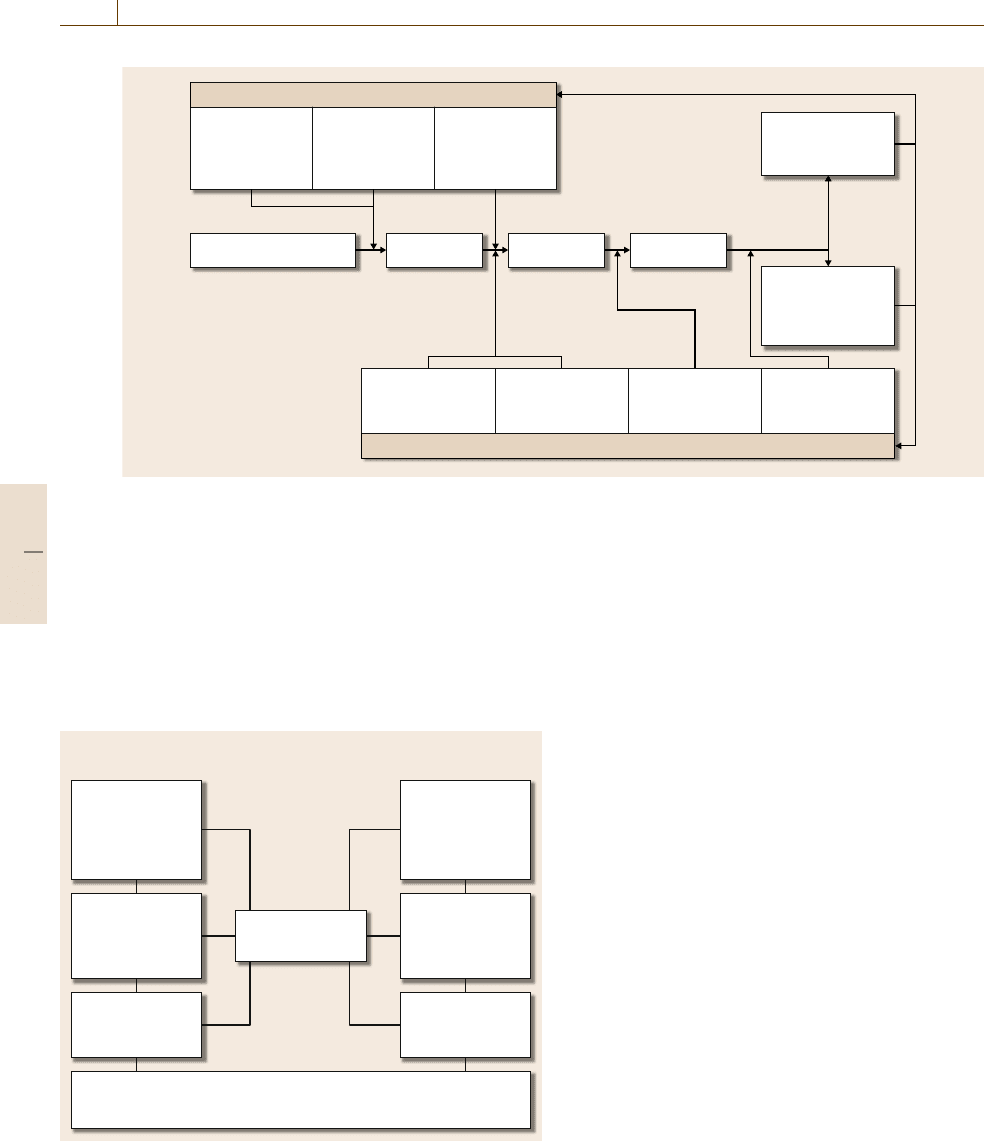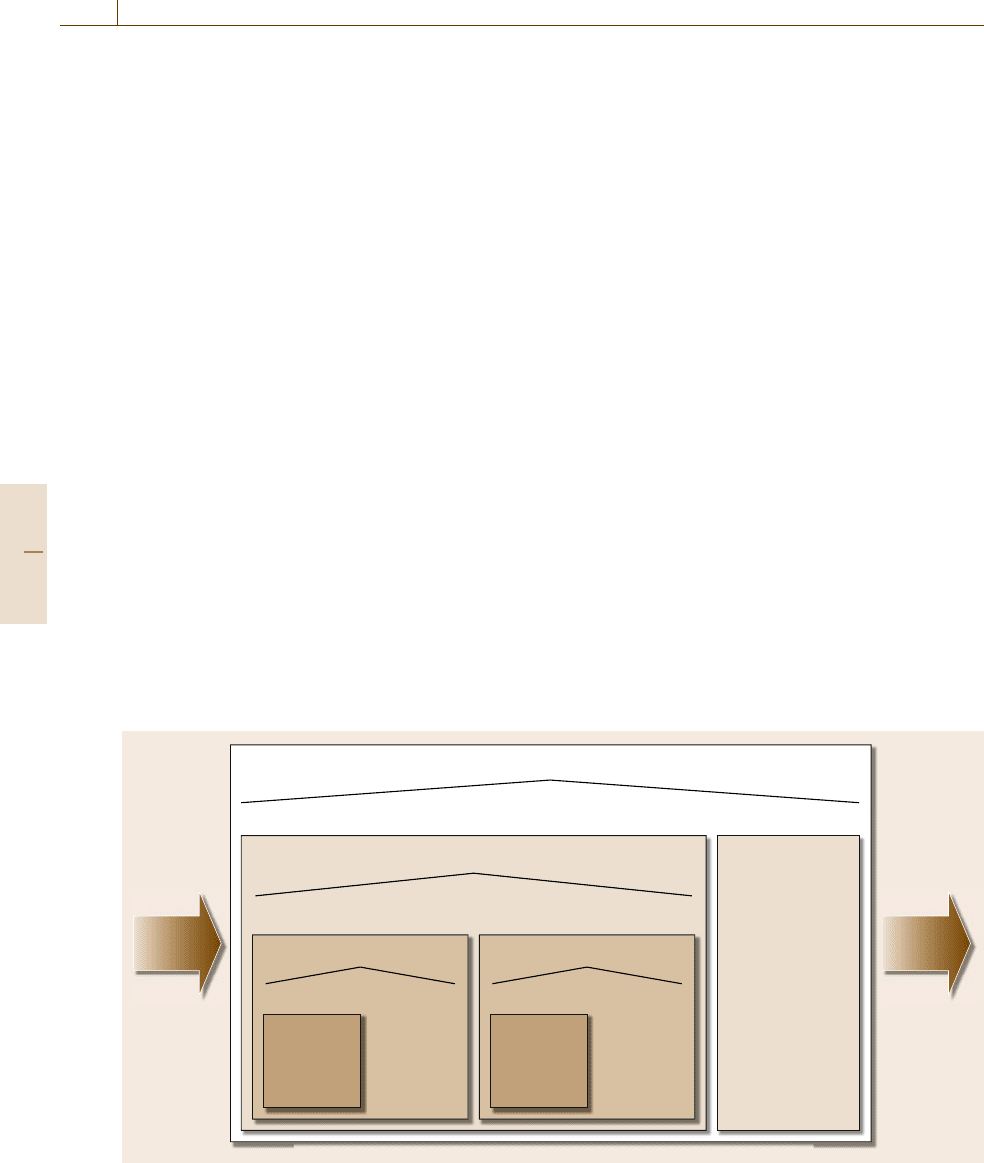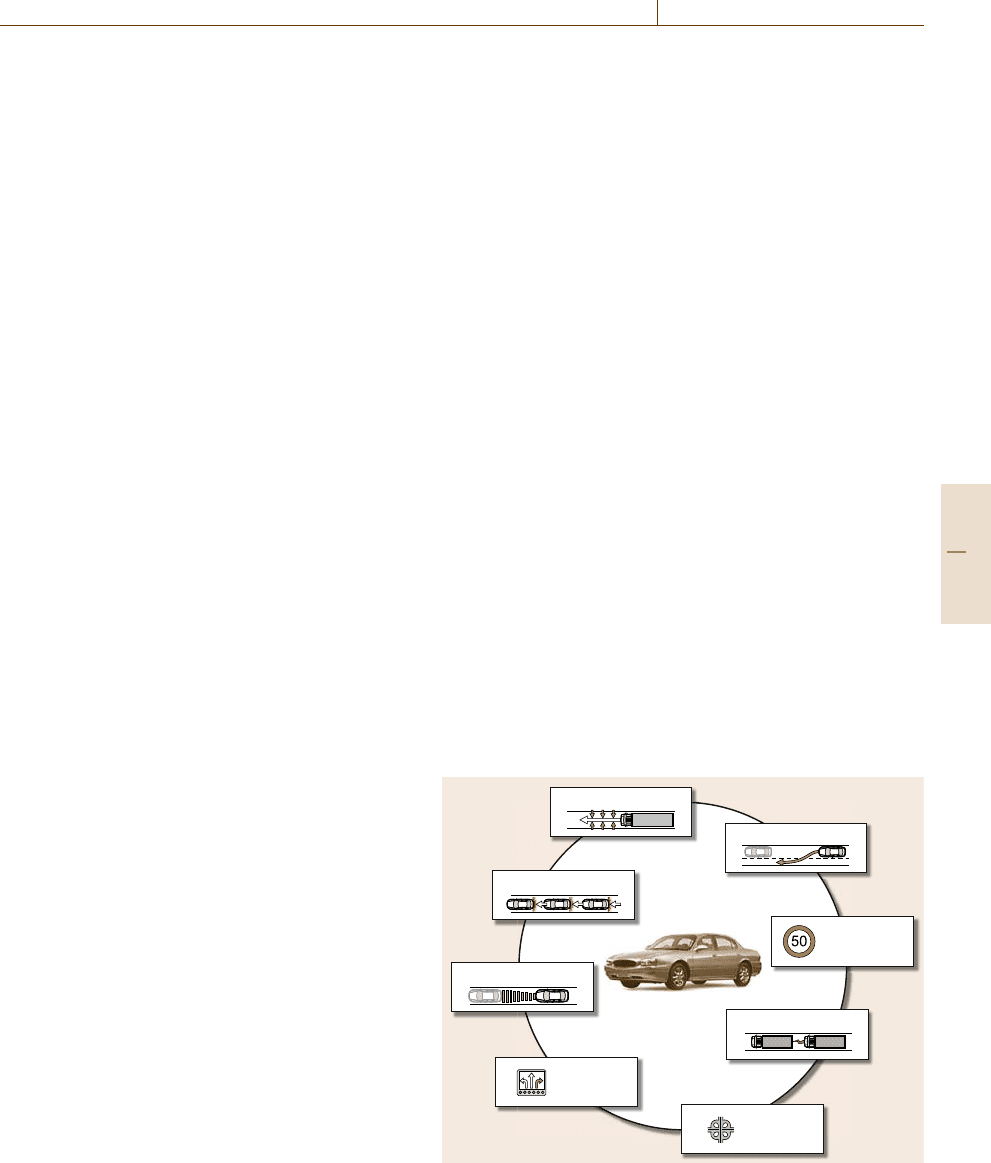Nof S.Y. Springer Handbook of Automation
Подождите немного. Документ загружается.


Integrated Human and Automation Systems 34.1 Basics and Definitions 575
Man–machine system
Event-driven
dialogue system
Dynamic system
Communication
tool
Manually controlled
system
Master display
Partly automated/
hybrid systems
Vehicle (air,
water, land)
Partly automated
traffic system
Master–slave
system
Partly autonomous
mobile robot
Fig. 34.2 Types of man–machine systems [34.8]
•
Communication: Creation of communication inter-
faces as well as sending and reception of informa-
tion
•
Scanning and evaluation of the situation: Scanning
of state variables of the system and the environ-
ment, directly via the natural senses or indirectly via
technical sensors and displays
•
Planning: Determination of distance from start to
destination
•
Navigation: Compliance with the planned distance
and estimation
•
Stabilization: Maintenance of necessary positions
(for example, machine direction control on the
street)
•
System management: Utilization and supply of sub-
systems as well as error diagnosis and elimination.
Fig. 34.3 Ticket machine as an event-driven dialogue sys-
tem
Another application range with manual control is
the master–slave system used for telepresence, i. e., the
enhancement of man’s sensorial and manipulation ca-
pacities in order to work further away. The teleoperator
benefits from sensors, actuating elements, and mul-
timodal channels of communication to and from the
human user. This creates a telepresence from a tele-
workplace for the operation in a nonadmissible physical
environment – for example, over large distances or in
microworlds [34.9].
We sometimes find automatic regulation of state
variables (Sect. 34.1.5)inpartly automated systems.
During automated processing, the worker is placed out-
side of the closed loop, but nevertheless supervises the
automated process and handles disturbances.
Hybrid systems characterize a simultaneous situa-
tion- and function-oriented combination of manual or
automated processing of the task within a collective
work system. Due to flexible adaptation of the degree
of automation, we aim for optimal usage of the specific
and supplementary capacities or characteristics of man
and machine [34.10].
Planes and cars are representatives of partly auto-
mated systems. As we do not want to rely solely on
automaton when using partly automated transportation
systems, a human observer is assigned to the sys-
tem. In this way intervention is guaranteed in case of
breakdown.
Another category of man–machine systems is partly
automated robots. Here, the human being undertakes
mission management by transmitting goals to a re-
moved, partly automated robot, controls its actions, and
Part D 34.1

576 Part D Automation Design: Theory and Methods for Integration
compensates for its errors. The user retrieves informa-
tion from the system, for example, information about
the which tasks to accomplish, difficulties, the robot,
and the distant application environment.
34.1.5 Man–Machine Interaction
The interaction between man and machine deals with
the user-friendly design of interactive systems and their
man–machine interface in general. Man interacts with
the technical system(Sect.34.1.3) via the man–machine
interface.
Usability is an essential criterion for the man–
machine interaction. The design of a man–machine in-
teraction takes account of aspects of usability engineer-
ing, context analyses, and information design [34.11].
To provide the user with programs, which the untrained
worker is able to learn quickly and the professional can
use in a productive and accurate way, is the goal of
software ergonomic technologies.
Computer-basedword-processing systemsare agood
example of a man–machine interaction. In the past,
computer systems often used text-based man–machine
interfaces. In the meantime, the graphical desktop has
become the main interface; even language and gesture
identification are becoming increasingly important.
34.1.6 Automation
To assign functions to a machine, which once were
accomplished by man, is the goal of automation. The
degree of automation is determined by how many
subfunctions are done by man or by the machine. Au-
tomation is also characterized by process control, which
beyond mechanization is also a result of the technical
system [34.12]. Depending on the complexity of the
control tasks, we differentiate between complete and
semiautomatic functions:
•
A complete automated system of a machine does not
need any human support. The machine completely
relieves man from work. Complete automation is
appropriate or functional when the worker cannot
complete his work precisely enough, when he is not
able to complete it at all, or when the working task,
for example, is too dangerous for him.
•
Semiautomation is a work characteristic of a ma-
chine that only needs some degree of support from
man. In contrast to a completely automated system,
semiautomation does not achieve complete relief
from work for the worker. The control of the indi-
vidual functions is usually achieved by the technical
system. Program control, which means the start,
end, and succession of the individual functions, is
accomplished by man.
Numerical controlled machines can switch between
semi- and complete automation while working. So-
lutions for automated systems have to correspond to
human and economical criteria. Automated workplaces
can lead to work relief and decrease of physical strain
due to the elimination or limitation of certain situa-
tions and their necessary adaptations. Automation can
free theworker from hazardous work tasks,which could
influence hishealth. Good examples forthis case are au-
tomatic handling machines. In relationto humanization,
the following criteria promote automation:
•
Abolition of monotone work
•
Abolition of difficult physical strain due to unfavor-
able body position and exertion, for example, lifting
heavy parts
•
Abolition of unfavorable environmental impact, for
example, provoked by heat, dirt, and noise
•
Reduction of risk of accident [34.4].
The design of complete work tasks creates better work
conditions. To reach this goal we need qualitative job
enrichment based on new combinations of work tasks
as well as the realization of new work functions.
Problem shifting can occur as well. Automation
changes the job requirement in terms of attention, con-
centration, reaction rate and reliability, combination
capacity, and distinct optical and acoustical perceptual
capacity [34.13].
Due to the combination of manual and automated
functions, we aim for adequate and practical application
of specific human/engine capacity resources in hybrid
systems [34.14].
34.1.7 Automation Technology
Automation technology refers to the use of strate-
gies, methods, and appliances (hardware and software),
which are able to fulfill predetermined goals mostly
automatically and without constant human interfer-
ence [34.15]. Automation technology addresses the
conceptualization and development of automatons or
other automatically elapsing and technical processes in
the following areas:
•
Engine construction, automotive engineering, air
and space technology, robotics
Part D 34.1

Integrated Human and Automation Systems 34.1 Basics and Definitions 577
•
Automation of factories and buildings
•
Computer process control of chemical and procedu-
ral machines
•
Traffic control.
Process automation (during continuous processes such
as power generation) and production automation (for
discrete processessuch as assembly of machines or con-
trolling of machine tools) are main application areas in
the field of automation technology.
34.1.8 Assisting Systems
Assisting systems are components of man–machine
communication (Sect.34.3.4). Assisting systems do not
substitute a human being, but support him occasionally
while accomplishing tasks that overburden or do not
challenge him enough. An assisting system should:
•
Reduce the subjectively felt complexity of a techni-
cal system
•
Facilitate the spontaneous use of a technical system
•
Enable fast learning of the functions or handling of
the system
•
Make the use of the system more reliable and se-
cure.
Assistance creates a connection between the demands,
capabilities, and capacities of the user on the one hand,
and the functions of the interactive system on the other.
The followingassisting functionsseem relevant[34.16]:
•
Motivation,activation, and goal orientation (i.e., ac-
tivation, orientation, and warning assistance)
•
Information reception, and perception of signals
of interactive systems and of environmental in-
formation (i.e., display, amplifier, and repetition
assistance)
•
Information integration and production of situa-
tional consciousness (i.e., presentation, translation,
and explanation assistance)
•
Decisiveness to take action, to decide and choose
a course of action (i.e., offer, filter, proposition, and
acceptance assistance; informative and silent con-
struction assistance)
•
To take action or carry out an operation (i.e., power
and limit assistance; input assistance)
•
Processing of system feedback or of a situation(i. e.,
feedback assistance).
As an example, we use assisting systems through per-
sonal computer (PC) software, automatic copilots in
planes and vehicles, in the form of personal digital as-
sistants (PDAs), or as part of smart-home concepts.
Assisting systems can be differentiated according
to their adaptation of different user profiles, tasks, and
situational conditions [34.17]:
•
Constant assisting systems always show the same
conduct, independent of the operator or situation.
Their advantage is consistency and transparency.
However, these systems are inflexible; the provided
support does not always suit the user nor the situa-
tion.
•
Assisting systems designed according to user spec-
ification adjusted to the needs of certain users and
their tasks in specific contexts. This kind of adjust-
ment proves to be problematic when, for example,
the context of usage changes.
•
Adaptable assisting systems can be adjusted by the
user to specific needs, tasks, and situations of use.
The calibration of assisting systems occurs via se-
lection or adjustment of parameters. The user takes
the initiative to adjust the system.
•
Changes of adaptive assisting systems do not oc-
cur on the basis of explicit guidelines given by the
user, but through the system’s evaluation of actual
and saved context characteristics. Adaptive systems
autonomously adjust assistance to the user, his pref-
erences, and needs in certain situations.
34.1.9 The Working Man
The development and evaluation of human-oriented
work (Sect.34.1.1) requires knowledge about the hu-
man factors. Selected work-scientific concepts are
described below.
ConceptofStressandStrain.All human requirements,
which evolve from workplace, work object, work orga-
nization, and environmental influences, are part of the
notion of stress and strain, which concept describes
the defined reaction of the individual body to external
stress (or workload). Individual capability is the factor
connecting impact and stress [34.1]. The workload and
individual capabilities are decisive for the strain factor.
The higher the impact of the workload, the more
the worker has to use his individual capabilities in or-
der to fulfill the task effectively. Figure 34.4 shows
an ergonomic stress–strain model. This stress–strain
concept has been primarily described for the field of
physical labor, but can also be used when talking about
psychological stress.
Part D 34.1

578 Part D Automation Design: Theory and Methods for Integration
Situational factors
Duration and
frequency
Workload Stress Activities
Individual factors
Strain
Environmental
influences,
State of work
design
Emotionally
effective
influences
Adjustment:
Training,
Recreation etc.
Functional
modifications:
Fatigue
damage etc.
Stress/health
damage
threshold
Physiological-
functional
characteristics
Disposition:
Capabilities,
Capacities
Drive:
Motivation,
Concentration
Fig. 34.4 Stress–strain model (according to [34.18])
Prerequisites for Performance.
The entirety of infor-
mation processing and energy transformation, which
leads to the achievement of a goal, is defined as
work performance. In order to be work efficient, we
need human and objective prerequisites of performance
(i.e., work organization and technical facilities). Hu-
man prerequisites for performance refer to capability
and motivation (Fig.34.5).
Physical
capability
Psychological
capability
Capability
Output of information
Effectors/nervous system, reaction/coordination
Flexibility
Bones and
ligaments
Information
reception/sensory
perception
Senses and
receptors
Information
processing
Central nervous
system
Saving
of information
Brain
Evolvement
of force
Muscles and
tendons
Endurance
Cardiovascular
system
Fig. 34.5 Capability factors
The term physical motivation comprises the sum
of all biological body activity. It is limited to physical
aspects. Work performance is not a constant fac-
tor, but undergoes changes. In order to be efficient,
physical performance requires several psychological
performance prerequisites, such as motivation, willing-
ness of effort, and cognitive understanding of the task.
These factors are called psychological motivation.
Stress. Task-related stress results mainly from the
comprehension and processing of information, the
movement of the body, and the release of muscle
power when using work equipment. Comprehension
and processing of information occurs through sensor
and discriminatory work. Perception stresses our vi-
sual, auditory, haptics/tactile, and proprioceptive sense
organs. Discriminating work leads to stress, based on
recognition and identification of signals. The intensity
of stress, which results from the work function, depends
on:
•
The duration and frequency of the task
•
The complexity of the task itself and of different
work processes
•
The dynamics of the processes that need to be con-
trolled
•
The expected precision of the accomplishment of
the task
•
The level of concentration required while working
Part D 34.1

Integrated Human and Automation Systems 34.2 Use of Automation Technology 579
•
The specific characteristics of appearing signals
•
Flexibility of comprehension of the information.
Stress that results from the work environment can result
from a physical,chemical or social cause thatmay affect
factors such as lighting, sound, climate, and mechani-
cal vibration. Bodily stress can be provoked by manual
handling of heavy loads or work equipment due to inap-
propriate body movement and enforced body position.
Workplace conditions that demand a static body posi-
tion are very stressful for the body as the circulation of
blood is negatively affected.
Stress from work organization can result from reg-
ulation of the work schedule (for example, shift work),
operating speed, the succession of tasks, inappropriate
amounts of work during peak times, lack of influence
on one’s work,strict control, and uniform tasks. We also
speak of stress when a task demands constant willing-
ness of action, even though human interference is only
necessary in exceptional cases [34.19].
The operationof information (for example, complex
information or information deficits) can also provoke
further situations of stress.
Strain. We differentiate between physical and psycho-
logical strain. Consequences of strain present them-
selves on a muscular–vegetative or cognitive–emotional
level. Disturbances of the psychophysical balance are
provoked by either excessive or unchallenging situa-
tions. Both of these situations imply that the individual
prerequisite of performance does not correspond to the
corresponding performance condition. In the case of an
excessively challenging situation operational demands
exceed the individual’s capability and motivation. Un-
challenging situations are characterized by the fact that
individual capabilities and needs are not sufficiently
taken into consideration. Both situations can lead to
reversible disturbance of the individual performance
prerequisite, such as tiredness, monotony, stress, and
psychological saturation. On the level of performance,
they can cause changes in work processing (e.g., out-
put and quality). These disturbances can be eliminated
by a change of physical and psychological performance
functions, as well as by implementing phases of recov-
ery time. Nevertheless, disaccord between strain and
recovery can only be tolerated for a limited period of
time [34.20].
34.2 Use of Automation Technology
Automation technology can be found in many fields at
work as well as in public and private life. Examples of
automation technologies are:
•
Assembly automation (factory automation)
•
Process automation in chemical and procedural
facilities
•
Automation of office work
•
Building automation
•
Traffic control
•
Vehicle and aeronautical technology.
Increasing functional and economical demands as
well as technical development will lead to ongoing au-
tomation of technical systems in many different walks
of life and work – from the office to factory level.
Regarding automation effort we can identify two devel-
oping trends [34.21]:
•
Increase of complexity of automation solutions via
enhancement and process-oriented integration of
functionalities: linked and standardized control sys-
tems are increasingly replacing often proprietary
isolated applications. The continuous automation of
processes and work systems leads to an increase of
effectiveness and quality as well as to a decrease of
costs in industrial processes of value creation.
•
The increasing effectiveness of automation and con-
trol techniques and miniaturization of components
leads to decentralization of control systems and
their integration on-site. Next to process automa-
tion, more and more often, we also find product
automation.
Information technology, which continues to produce
more powerful hardware components, is a driving force
for this development. Selected areas of application,
which are characterized by a high degree of interac-
tion between man and technology, will be presented in
the following sections. Partly automated systems and
assisting systems will be one focus of the following
elaboration.
34.2.1 Production Automation
Production automation is a discipline within the field
of automation technology that aims at the automa-
Part D 34.2

580 Part D Automation Design: Theory and Methods for Integration
tion of discontinuous processes (i. e., discrete parts
manufacturing) using technical automatons. Production
automation is engaged in the entirety of control, closed-
loop control devices, and optimization equipment in the
space of production facilities [34.22].
Through history, production automation shows sev-
eral levels of development, starting with automation
related to the working process and ending with complex
assembly automation. In the early days of automa-
tion, extensive complete processing of specific work
objects was the focus. This development started with
numerically controlled (NC) machine tools, following
by mechanical workstations, reaching the level of flexi-
ble processing systems.
Flexible production systems are based on the ma-
terial and informational linking of automated machines.
They are characterized by the integration of the func-
tions of transportation, storing, handling, and operating,
and comprise the following subsystems:
•
Technical system
•
Flow of material, maintenance, and disposal system
•
Storage system and application system
•
Information and energy system
•
Equipment system, machine system, and inspection
equipment system
•
Maintenance system.
Flexible production systems are designed for an assort-
ment of geometrical and technological work equipment.
Level 4: flexible production system
Level 3: flexible manufacturing cell
Level 2: machine
Level 1:
tool, object,
machine
Level 1:
tool, object,
machine
Level 2: machine
Level 3:
flexible
manufacturing
cell
Input Output
Process integration of technical and organizational functions, linked control
Singular performance
Power drive
local control
Power drive
local control
Individual handling operation
Integration of handling operation,
material flow, coordinated control, supporting functions
Fig. 34.6 Shell model of production automation (according to [34.14])
Due to the marginal effort required for their adjust-
ment they can be fitted to changing production tasks
as well as to fluctuating capacity loads. Control of the
corresponding subsystems can be realized by a linked
computer system, which takes into account machining
situations, storage, and transport systems among others,
and which receives requirements from a central pro-
cessing control. The computer system controls usage of
the appropriate machines, appropriation of the techni-
cal control programs, availability and progress controls,
logging of production, and information from the main-
tenance service. An agent can influence the system in
case of disturbance. Figure 34.6 summarizes the differ-
ent levels of the respective machines up to the flexible
production system.
A main technical component of production au-
tomation is the industrial robot. An industrial robot
is a universally usable automaton with at least three
axes, which have claws or tools, and whose movements
are programmable without mechanical interaction. The
main application areas of industrial robots are welding,
assembling, and handling of tools.
The present level of development of produc-
tion automation exhibits process-related integration of
computer-based construction (computer-aided design,
CAD) and production (computer-aided manufacturing,
CAM). Process-oriented CAD/CAM solutions result
in a continuous information processing system dur-
ing the preparation and execution of production, in
Part D 34.2

Integrated Human and Automation Systems 34.2 Use of Automation Technology 581
which data is produced and managed automatically
and is circulated to other fields of operation (for ex-
ample, systems of merchandise management). During
the complex and continuous process of automation,
development and production as well as the correspond-
ing business fields are informationally and materially
linked with each other. Continuous solutions are the ba-
sis of an automated plant, which at first only captures
selected production areas, but then entire compa-
nies [34.23].
An extreme degree of automation is not always the
perfect solution for manufacturing technology. If fewer
pieces and complex tasks determine the production,
the usage of less automated systems is a better solu-
tion [34.24]. Robots reach their limit if the execution
of the task demands a high degree of perception, skill,
or decisiveness, which cannot be realized in a robust or
cost-effective way.
Unpredictable production range and volume as well
as higher costs and quality demands increase the area of
conflict between flexibility and automation in the pro-
duction. Due to progress in the field of man–machine
interaction and robotics, the field of hybrid systems has
become established, in which mobile or stationary as-
sisting robots represent the most economical form of
production [34.25]. Assisting robots support flexible
manual positions by accomplishing tasks together with
the human being.
Man’s sensory capabilities, knowledge, and skill are
thus combined with the advantages of a robot (e.g.,
power, endurance, speed, and preciseness). Assisting
robots can now not only handle special tasks, but also
cover a broad spectrum of assistance of widely different
tasks. Figure 34.7 shows an exemplary utilization of an
assisting robot while assembling.
An assisting robot can either be installed stationary
at the workplace or used in a mobile way at different lo-
cations. In both cases the movement and workplace of
man and robot overlap. In order to make it possible for
man and robot to cooperate efficiently in complex situa-
tions, it is necessary that the robot system has a sensory
survey of the environment and an understanding of the
job definition.
34.2.2 Process Automation
Chemical and procedural industries use automation,
first and foremost, for monitoring and control of au-
tonomous processes. This can usually be realized by
the application of process computers, which are directly
connected to the technical process. They collect situa-
Fig. 34.7 Hybrid system during assembly (photo was
taken with permission of Fraunhofer IPA)
tional data, analyze errors, and control and optimize the
process.
Interaction of man and technology is limited
to man–machine communication when using process
computers and control equipment. Section 34.3.4 will
elaborate on these aspects in more detail.
34.2.3 Automation of Office Work
In this regard, we can differentiate between informa-
tional and manual office work. Manual office work
can especially be found in the infrastructure sector.
The use of decentralized computer technologies close
to the workplace accelerates the automation of algo-
rithmic office work with manual and informational
character.
Automation of office processes aims to increase
work efficiency. Some business processes can only be
realized by use of technology. The comprehensive in-
formation offered by the Internet is, for example, only
usable by computer-based search algorithms.
Workflow systems are important for the automa-
tion of infrastructural office work. They use optimized
structures of organization for the automation of work
processes. They influence the work process of each
individual worker [34.26] by allocating individual pro-
cedure steps and forwarding them after processing.
Part D 34.2

582 Part D Automation Design: Theory and Methods for Integration
Workflow systems support among others the following
functions:
•
Classification, excavation, and removal of informa-
tion carriers in an archive
•
Physical transport of information carriers
•
Recognition of documents and transmission to the
appropriate agent
•
Connecting of incoming documents with previous
information (for example, an incoming document
will be connected with previously saved data about
the client)
•
Deadline monitoring and resubmission, capacity ex-
change in case of employer absence (for example,
forwarding systems)
•
Updating of data in the course of the process of in-
dividual processing steps (e.g., verification of the
inventory when sending out orders).
Moreover, the use of automated work tools in the
form of copy technology, microfilm technology, word-
processing systems, and information transfer technol-
ogy contributes to an increase of efficiency in the field
of office work.
A characteristic of informational office work is tight
connection of creative and processing work phases. The
human being creates ideas, processes the task, and eval-
uates the results of the work. As organizational task are
algorithmatized and delegated to the computer, the ma-
chine can support the working man [34.27]. Man has
the possibility to intervene in the process by correcting,
modifying, evaluating, and controlling it. Computer-
based work connects the advantages of a computer, for
example,high-speed operations and manipulation ofex-
tended data, with man’s decision-making ability in an
optimal way. Computer-based work does not eliminate
man’s creativity, but rather reinforces them. New solu-
tions will also be bound to man’s creativity.
34.2.4 Building Automation
The term building automation defines the entirety of
monitoring, control, and optimization systems in build-
ings. It is part of technical facility management. This
includes the integration of building-specific processes,
functions, and components in the fields of heating,
ventilation, climate, lighting, security, or accession con-
trol. The continuous cross-linking of all components
and functions in the building as well as their de-
centralized control are the characteristics of building
automation [34.28].
Building automation aims to reduce costs of build-
ings via a methodological approach to planning, design,
construction, and operation. For this, operational se-
quences are conducted in an independent way or
simplified in their handling or controlling. Functions
can, for example, be aligned according to changing op-
erating conditions (season, time of day, weather, etc.)
and activities can be combined into scenarios.
Due to constructionautomation the technical and or-
ganizational degree of complexity increases as well as
the demand according to a functional integration. Here,
we have to differentiate between the demands and needs
of different user groups (i.e., users, operators, and ser-
vice staff):
•
User: Functions of the MMS have to be reduced to
a necessary minimum. They have to be intuitively
comprehensible and easily manageable. Interfer-
ence in operationhas to bepossible at any time(with
the exception of safety functions).
•
Operator: MMS has to provide optimal support for
maintenance and support as well as optimizing op-
eration of the construction technology. Depending
on the object’s size and complexity, this can com-
prise a spectrum of simple fault indication up to
teleguided control systems.
•
Service staff: Operating functions, which are unnec-
essary in a common process, have to be available
exclusively to service staff.
34.2.5 Traffic Control
Traffic control means active control of the flow of traf-
fic by traffic management systems. Traffic telemetry is
a main application of traffic management systems, com-
prising all electronic control and assisting systems that
coordinate the flow of traffic automatically and support
driver routing [34.29]. Traffic telemetry has the follow-
ing goals [34.30]:
•
Increase of efficiency of existing traffic infrastruc-
ture for a high volume of traffic
•
Avoidance of traffic jams as well as of empty cars
and look-around drives
•
Combination of advantages of the individual car-
riers (that is to say, railway, street, water, air) and
integration into one general concept
•
Increase of traffic safety: decrease of accidents and
traffic jams
•
Decrease of environmental burden due to traffic
control
Part D 34.2

Integrated Human and Automation Systems 34.2 Use of Automation Technology 583
Traffic control depends on the availability of appropri-
ate trafficdata, which is collected by optical orinductive
methods, amongst others. The collected data is pro-
cessed in a primary traffic control unit and transformed
into traffic information, on the basis of which traffic
scenarios can be developed and traffic streams can be
processed. Manipulation of traffic streams occurs, for
example, through warning notices, speed limitations, or
rerouting recommendations.
Information on the infrastructure is carried out from
vehicle to driver through intercommunication signs,
light signals, navigation systems or radio.
Satellite-navigation systems are widely used in ve-
hicles; they carry out supported route calculation and
vehicle-specific traffic control or goal orientation. Tele-
metric systems are also used for mileage measurement
in regard to road charging.
Traffic telemetry appliances can avoid or lessen
disturbances and optimize traffic flow in a timely, ge-
ographical, and modal way [34.31]. Even though traffic
telemetry systems have great potential to ameliorate
the entire traffic situation, their usage is still limited.
One reason is the insufficient quality of collected data
regarding traffic and street status for traffic control. An-
other reason is that the possibility of intervention in
daily traffic is limited.
In the future, oriented adaptive traffic control sys-
tems will have to be able to dynamically link individual
and public vehicles as well as traffic data. In addi-
tion to stationary detectors, vehicle-generated traffic
announcements are also included in the area-wide ex-
tension of databases regarding traffic situation and
traffic prognosis. Mobil communication systems con-
tribute to the exchange of information between vehicle
and infrastructure.
34.2.6 Vehicle Automation
Automated systems are used in road vehicles and air
transportation. They support and control the driver or
pilot in his task.
Assisting systems in a car stabilize the vehicle (for
example,antiblock system,stability programs,brake as-
sistant, and emergency brake) and help the car to remain
in lane, maintain the correct distance to the car in front,
control lighting (for example, through an adaptive light-
ing system), assist in routing (for example, navigation
systems and destination guides), as well as accomplish
driving maneuvers and parking [34.32].
Moreover, assisting systems facilitate the usage
of numerous comfort, communication, and entertain-
ment functions in the vehicle. Figure 34.8 presents an
overview of assisting systems in a car. Assisting sys-
tems, which are only barely noticed, are for example,
a radio that automatically regulates the volume accord-
ing to the surrounding noise, a display that optimizes its
brightness according to the external light level, and au-
tomatic windscreen wipers that regulate their cleaning
intervals according to the force of rain. Nowadays we
combine several assisting functions into adaptive driver
assisting systems [34.33].
In order to support steering, numerous development
ideas have been discussed. The final goal is to cre-
ate a system that supports steering in order to stay
in lane and maintain the distance to the preceding
cars [34.34]. In this regard, a video camera records
the forward lane structure. With the help of some dy-
namic driving factors and evaluation of the captured
images, the system can determine the current position
of the vehicle relative to the lane markings. If the ve-
hicle diverges from the required lane, the driver will
feel small but continuous correcting forces through the
steering wheel. Using the same technology we can also
produce an alert in case of strong divergence from the
road, using a synthetically generated noise or vibra-
tion feeling. These stimuli reduce the possibility of
unintended divergence from the road and increase the
likelihood that an error will be noticed and corrected
early enough.
Another system that helps lane control and mainte-
nance of the correct distance to preceding cars is called
the electronic drawbar. This is a nontactile coupling be-
Sign recognition
Change lane assistant
Automatic lane assistant
Electronic drawbar
Highway
autopilot
City center
autopilot
Automatic distance keeper
Stop and go automatic
Fig. 34.8 Overview of an assistance system in a car
Part D 34.2

584 Part D Automation Design: Theory and Methods for Integration
Fig. 34.9 Adaptive, multifunctional driver-assistance
system
Table 34.2 Assisting systems in cars [34.8]
Modality/ Visual Acoustic Haptic Withoutinformation
assistance type
Intervention Antiblock system (ABS), Crash prevention,
servotronics, reflex belt pretensioner,
control, collision seat conditioning,
assistant sunroof
Command Lane control, Lane control,
problem report, distance keeping,
navigation order intersection assistant,
curve assistant
Consultation Navigation systems,
traffic jam alarm
Information Diagnoses systems
Table 34.3 Assisting systems in aircrafts [34.8]
Modality/ Visual Acoustic Haptic
assisting type
Intervention Maneuver delimiter,
quickening
Command Ground proximity Flight vector display,
warning system (GPWS) stick-shaker, callouts
Consultation Flight management
system (FMS), electronically
centralized aircraft
monitoring system (ECAM)
Information Navigation databank,
plane state variables
and maneuver borders
tween (usually commercial) vehicles based on sensors
and computer technology. The following vehicles fol-
low the leading vehicle automatically, as if they were
connected to the preceding vehicle with a drawbar. The
electronic drawbar should make it possible for just one
driver to lead and control a line of cars following each
other, all within a short distance. Due to the resulting
low aerodynamic residence, gas consumption should be
decreased.
Figure 34.9 shows a prototype adaptive, multifunc-
tional driver-assistance system in a car.
Advising navigation systems that react to the cur-
rent traffic situation are in serial production and show
increasingly better results. Integrated diagnosis sys-
tems refer to disturbances and maintenance intervals.
Table 34.2 presents the assisting functions accord-
ing to the realized assistant type. Moreover, this
Part D 34.2
